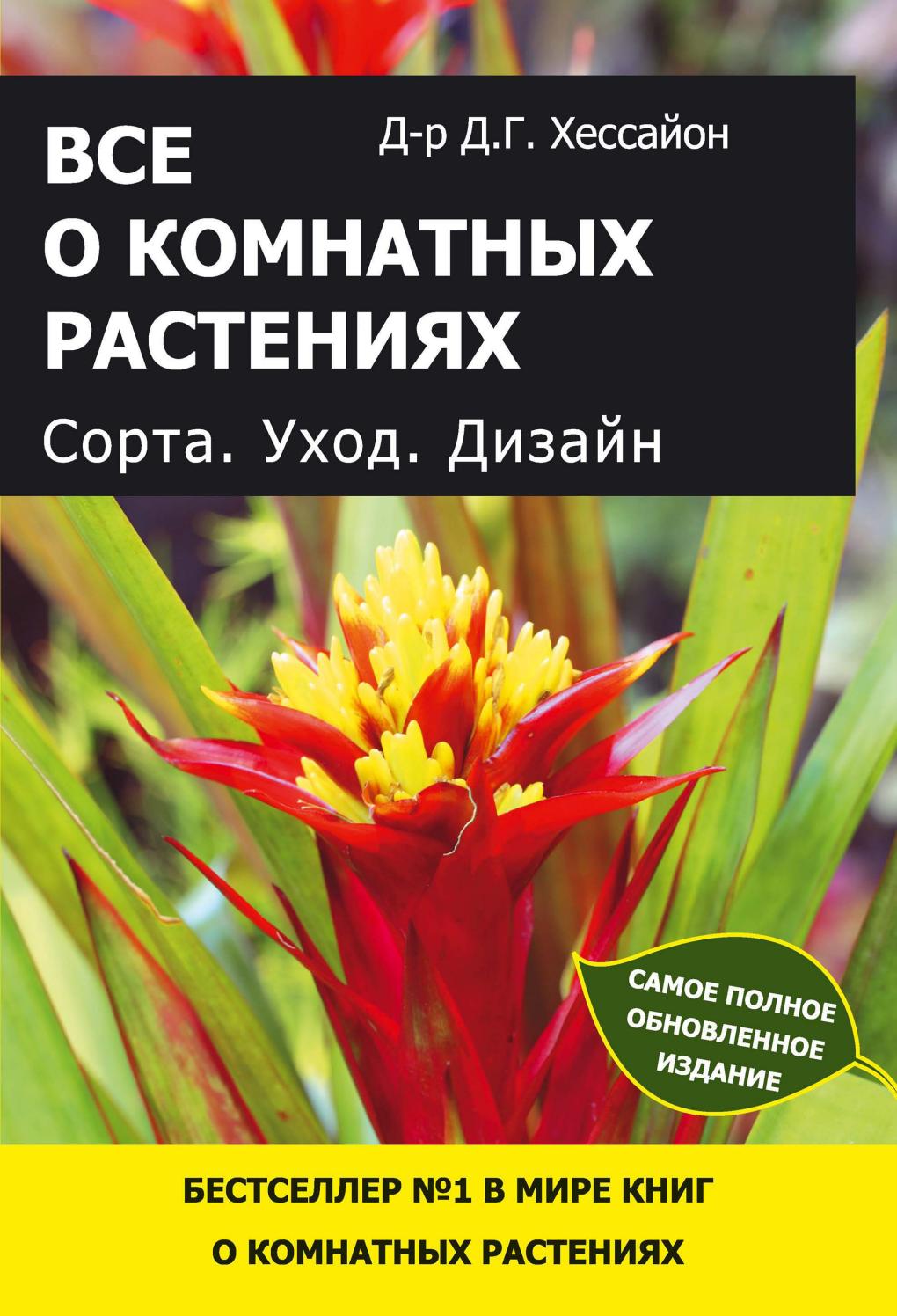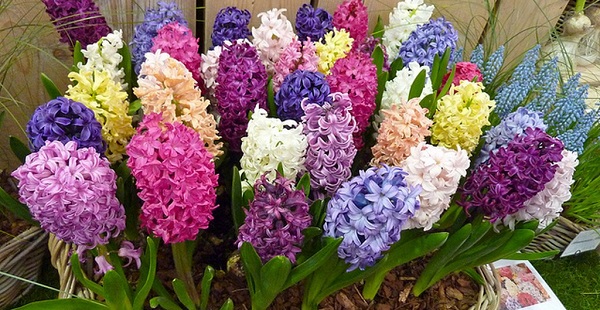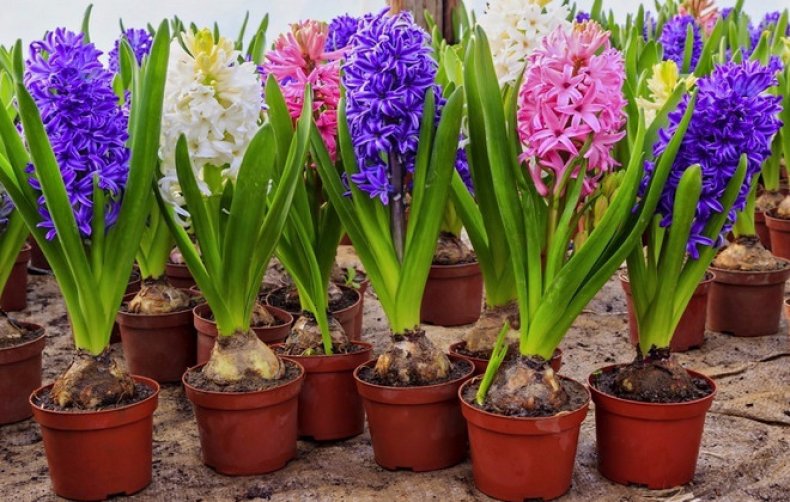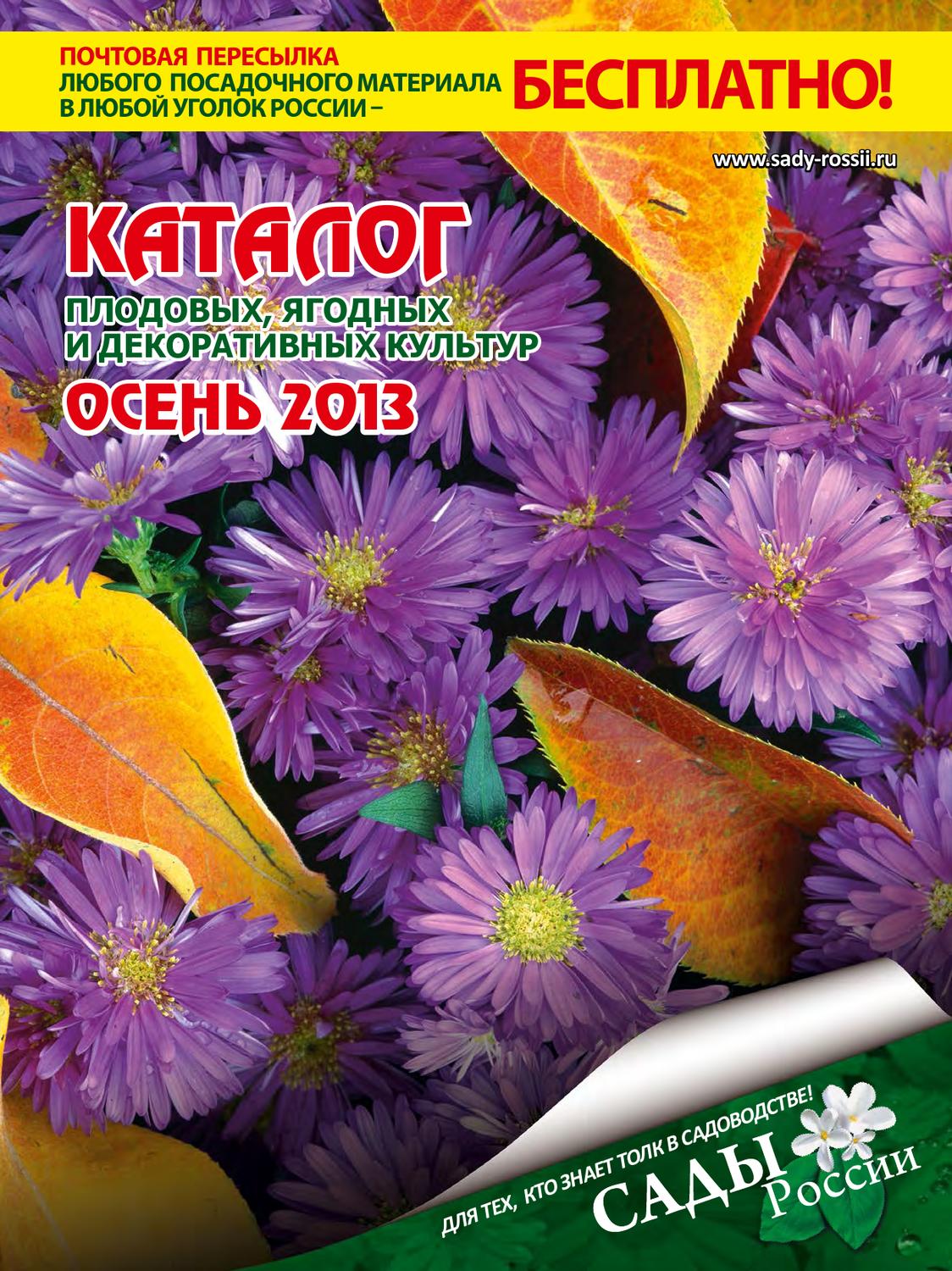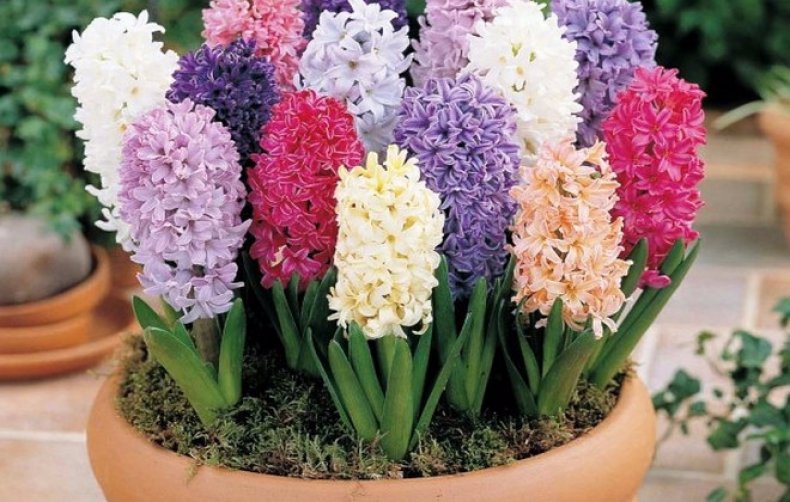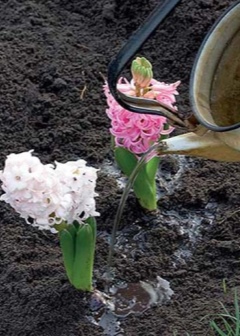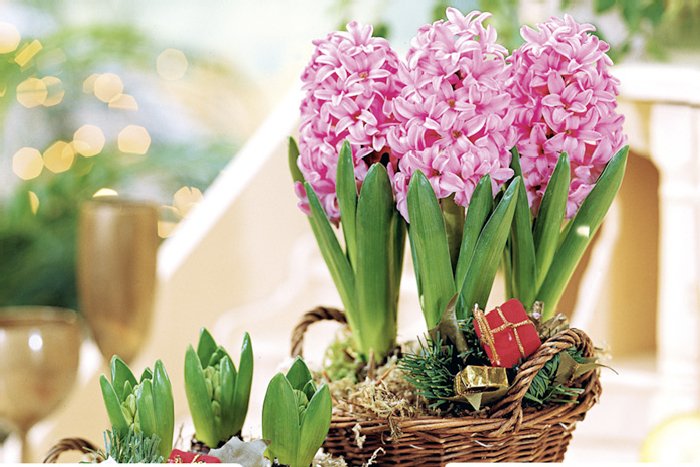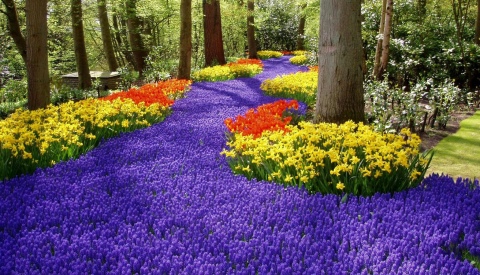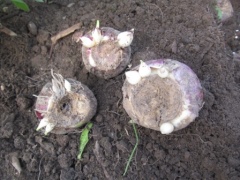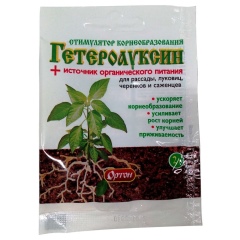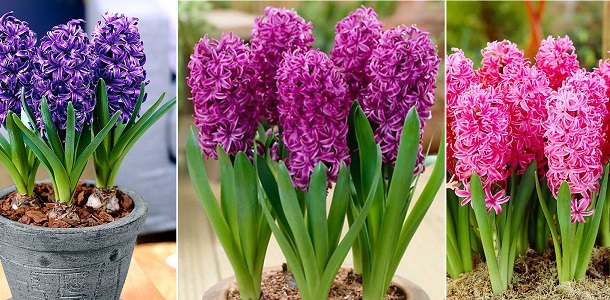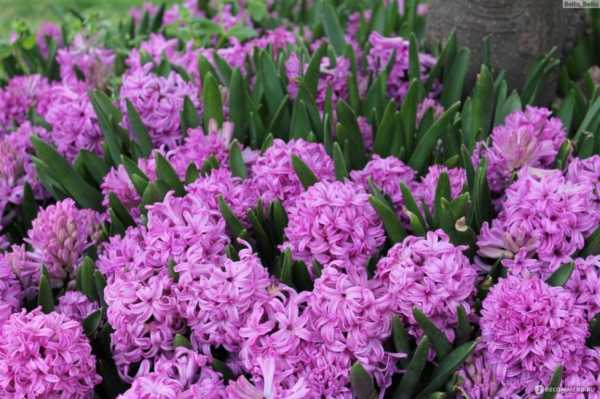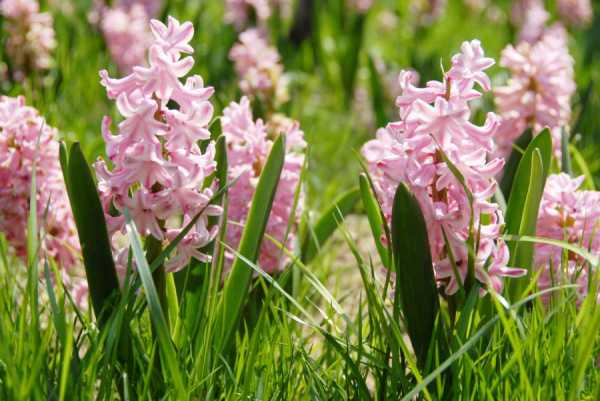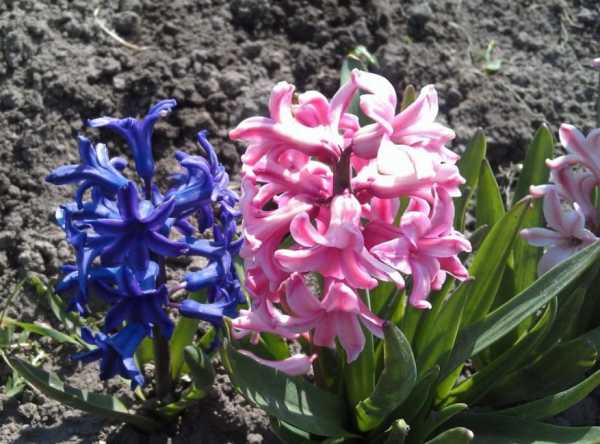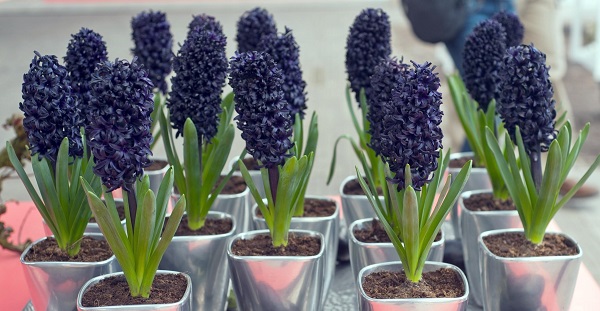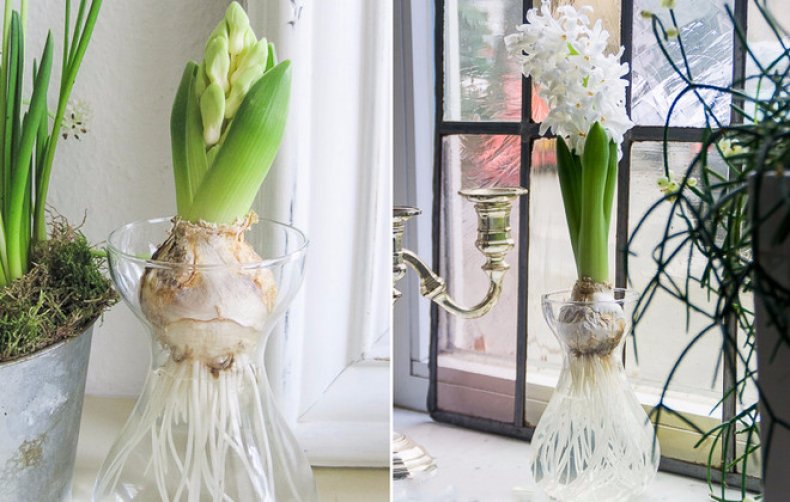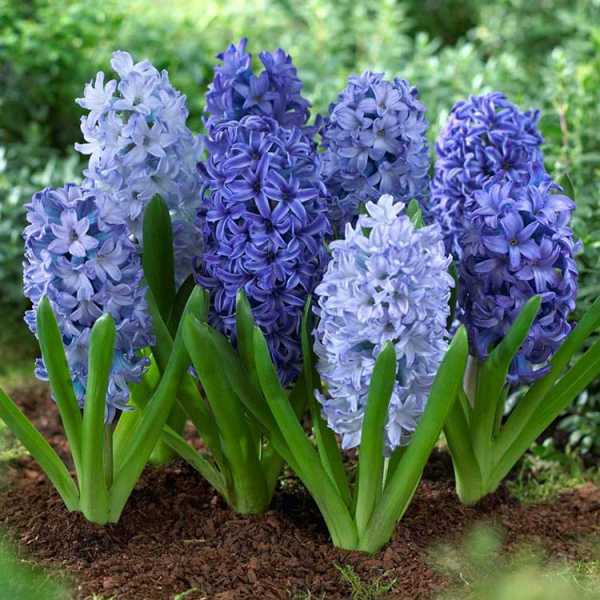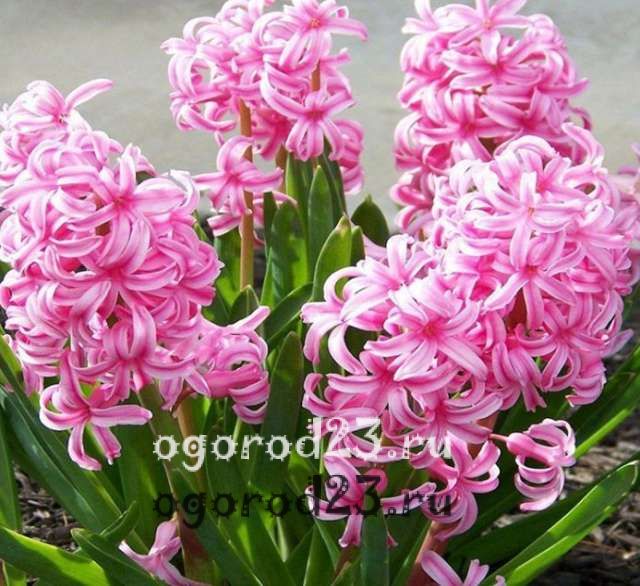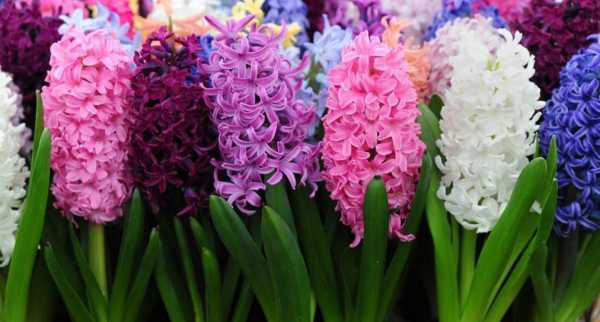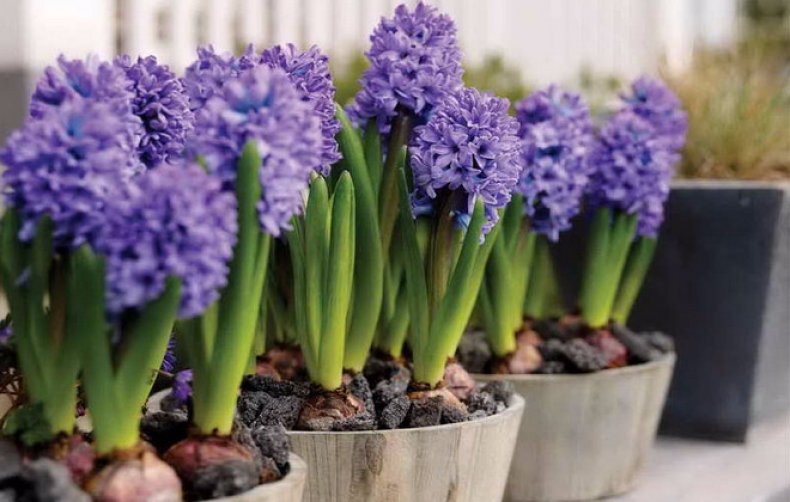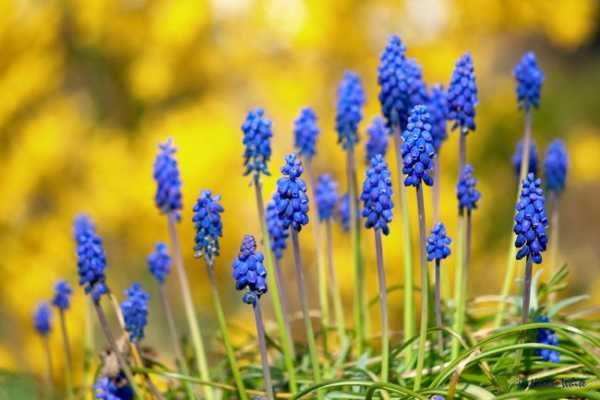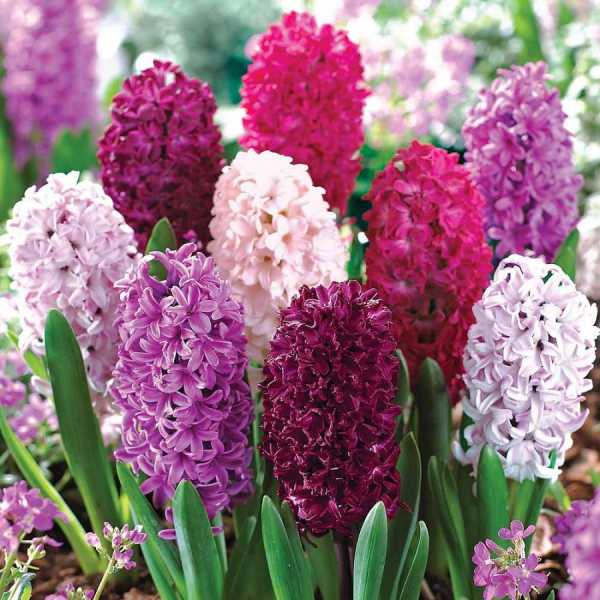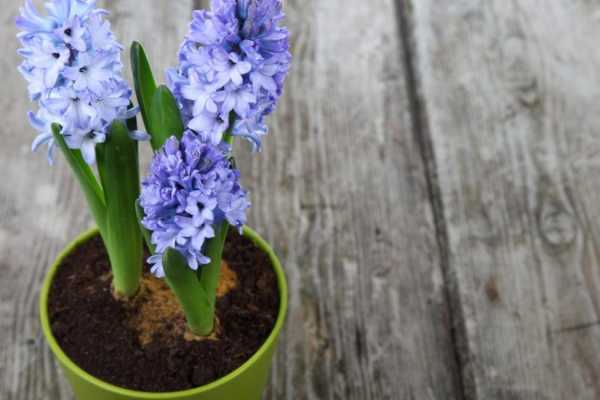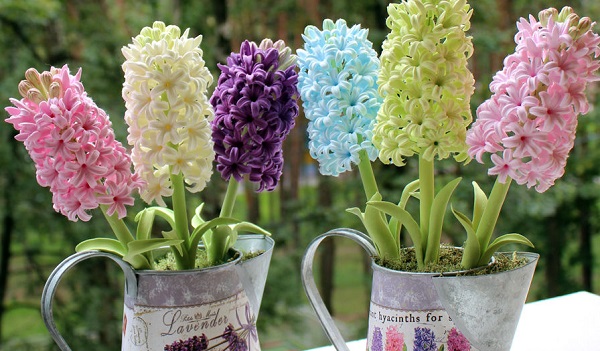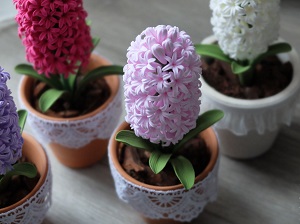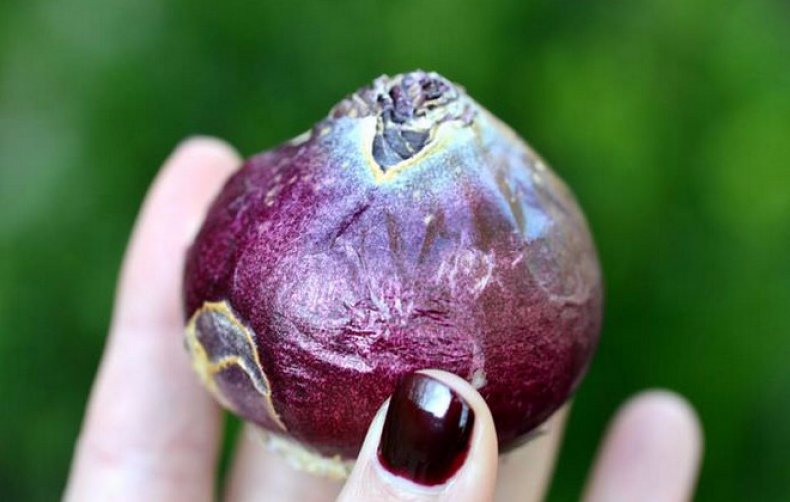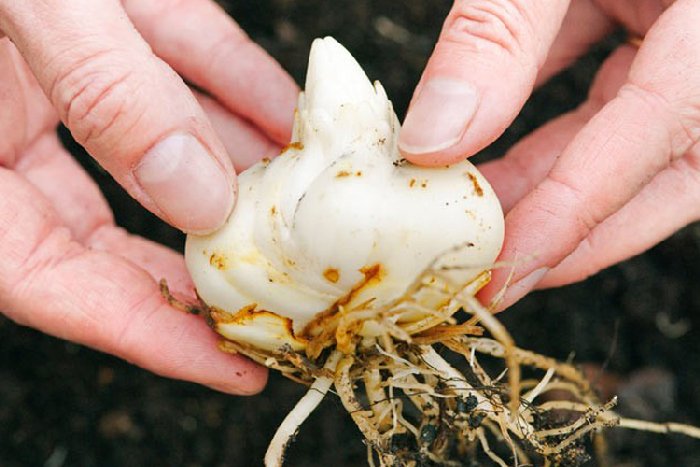Planting timing and soil preparation
When to plant hyacinths, many gardeners are interested. It is better to do this in the fall, in the last week of September - the first week of October. An earlier or later planting will lead to the death of the plant.
A flower bed is prepared 2 months before the expected date of planting hyacinthus bulbs. The selected place is dug to a depth of at least 40 cm, organic fertilizers (for example, humus or compost), potash and phosphorus fertilizers are applied.
Sand should be added to heavy soils, lime, chalk or ash should be added to highly acidic soils. The prepared bed is covered with a dark film or boards. Such a measure will prevent the appearance of weeds in the flower bed.
How to plant hyacinths in the spring in the garden
In spring, hyacinth bulbs are rarely planted. Most often, hyacinths bought in a store are taken for planting in open ground in the spring. These flowers should be planted following the steps below:
- When the hyacinth has faded, the peduncle is removed.
- The plant, along with an earthen clod, is taken out of the pot.
- A hole is made in the previously prepared soil to the depth of the pot.
- Sand is poured at the bottom of the hole as drainage.
- Put the hyacinth bulb together with the earthen clod in the hole and cover with soil.
- Water the plant around, being careful not to wet the bulb itself.
Important! Preparing the land for planting the purchased hyacinth should be started immediately after the snow melts. The dug earth must have time to settle
In the event of a threat of spring frosts, the planted flowers are covered with non-woven material.
Rules for planting hyacinths in the fall
In autumn, hyacinths are planted in late September - early October. A flower bed is prepared for planting at least 10 days in advance. After the earth has settled, holes are made for each plant. Sand is poured at the bottom of the recess, and an onion is placed. Around it, a sand pillow is made no more than 1.5 cm in thickness. Fertile soil is poured on top.
Important! The planting depth of the bulbs should be 3 times their height. The distance between the holes is made equal to the planting depth
After planting in dry soil, the plants are watered. If the soil is wet, then watering is not needed. You can plant tubers in a common garden bed, but in this case more sand will be needed. It is more expedient to make individual holes for planting in a large flower bed. When all the plants are planted, the flower bed is mulched with peat, straw or sawdust.
It is important to determine exactly when to plant hyacinths outdoors. When planted early, the plant will germinate and the young shoot will freeze
If you delay planting on the garden plot, then the tuber will not have time to take root and will die when frost sets in.
Fertilization and preparation for wintering
The main care for hyacinths, which allows you to get lush flowering plants, is their competent feeding. It is carried out in three stages:
- In the spring, when most of the planted bulbs give their first shoots, the soil is enriched with mineral compounds. On 1 m² of soil, 20 g of ammonium nitrate, 15 g of superphosphate and 10 g of potassium chloride are added.
- During the period of active bud formation, fertilizing is repeated using the same amount of ammonium nitrate, but increasing the proportion of the remaining components by about three times (superphosphate up to 40 g, and potassium chloride up to 20-30 g).
- When the plant has faded, it is fertilized with a mixture of superphosphate and potassium chloride in equal amounts (40 g each).
The feeding procedure should always be completed by loosening the soil. Fresh organic fertilizers are categorically contraindicated for hyacinths. Caring for perennials in the form of watering and feeding continues all the time as long as their leaves remain green.This will allow their bulbs to accumulate enough nutrients for future growth and flowering before entering the dormant stage.
To keep the plants from freezing in winter, they need shelter. You can save the beds from the cold with sawdust, spruce branches, straw, dry peat or humus. Hyacinths belong to primroses, and their sprouts break through the soil very early, therefore, they free the plantings from winter protection at the very beginning of spring. This must be done very carefully so as not to injure delicate seedlings.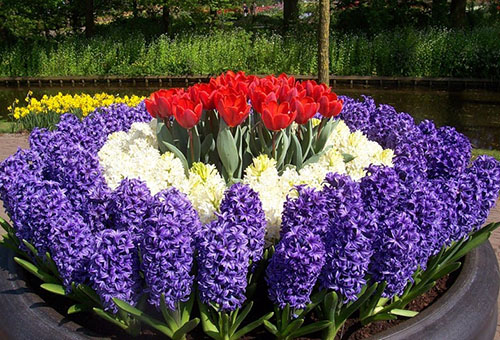
For all their touching charm, hyacinths are demanding and capricious plants. It is possible to expect that with the arrival of the first warm days they will bloom the garden with bright colors only if you provide them with proper care.
Competent planting, regular watering and weeding, adherence to the intricacies of feeding are the basic principles that must be adopted when growing these perennials. We'll have to be patient and devote a lot of attention and time to the beds with hyacinths. But how nice it will be to see the results of your labors, when in early spring the plant is thickly covered with delicate fragrant flowers!
Further care
It is also important to keep a close watch and look after the geocynts after planting. Namely:
Feed periodically. You can do without top dressing only if your soil is super-saturated and provides the plant with the entire spectrum of necessary trace elements, which is very rare in the Russian Federation. Primary feeding can be carried out as early as 1-2 weeks after planting. The second is when the buds begin to bloom. The third - when the flower is ready to "fall asleep". In addition to feeding, various organic fertilizers can be applied almost constantly (but do not forget to be interested in dosages and concentration of substances, they are always different).
Do not overfill! Remember the general rule for almost all bulbous species - do not forget that you do not need to fill them. Often, gardeners, watering the entire garden at once, fill all the beds in the same way. This is mistake. And the point is not that they do not like water, but that long "baths" of stagnant water make their bulb an attractive habitat for various flies, ticks, worms, etc. Also, any bacterial infection can settle in the bulb, to fight which the newly transplanted flower may simply not have enough strength and necessary substances.
Monitor the condition. If you notice flour plaque on the leaves, or the bulbs look somehow strange, and the flower itself is faded and looks unhealthy, this is a reason to think
It is important to diagnose the disease at an early stage - whether it be an insect or a bacterial disease, to cure it and prevent further occurrence the easier the sooner you discover something amiss.
The hyacinth has faded, but life goes on!
He is alive, and very often children even grow up in a pot next to each other. Well, how can you throw this away? In order to preserve the distilled hyacinth, you need to continue to care for it! This is the most important rule! The flowering period must necessarily be replaced by a dormant period, but the transition between them must be gradual.
Care for faded hyacinth step by step:
(method number 1 is the easiest)
- After the hyacinth has faded, the peduncle should be cut off (but not too short, it is enough to leave 10-15 cm). We leave the leaves.
- Now you need to gradually reduce watering. The faded hyacinth is watered only as the earth dries up, not as abundantly as during flowering, but from time to time.
- Gradually, the leaves will turn yellow, and by about mid-May, watering should be completely stopped and wait until the leaves are completely dry.
- The leaves are dry - we cut them off, and we take out the bulbs. It is necessary to remove the bulb from the pot as carefully as possible, clean it from the soil, cut off the dry leaves.
- Next, you need to dry the bulb a little in a dark, warm, ventilated room at a temperature from + 18 to +22 degrees.And store in such conditions until the autumn planting. A cardboard box or box is perfect for storage, but never in a bag.
Before drying, the bulbs can be pickled in a solution of potassium permanganate or "Maxim". You can store the bulbs at home. Hyacinths are not kept in the refrigerator. They are planted in open ground in late September - early October. Before the onset of frost, the bulbs in the soil will just have time to take root. In the spring, such hyacinths may not bloom, but only the next year.
Method number 2:
(let's call it "more confused")
- Part of the peduncle with withered flowers is cut off. Do not cut too short, just leave 10-15 centimeters. Leave the leaves! On YouTube, in one of the videos, I came across an advice to prune hyacinth leaves immediately after flowering, while they are still green. This is a gross mistake! The leaves should dry naturally. The transition of the hyacinth to the resting phase should be gradual. The leaves are still needed by the faded hyacinth to feed the bulb itself. Having deprived the plant of loes, we deprive the bulb of nutrition, and it will not be able to prepare itself as well for the dormant period as much as possible.
- So, the peduncle was pruned, the leaves were left. Now, together with the earthy clod, the plant is transferred into a larger pot so that the bulbs develop themselves and grow the children. They are planted so that the root collar is not buried. Why does a hyacinth need a spacious pot? The fact is that forcing flowers are sold in very small pots and there is practically no land there. But our task is for the hyacinth to slowly enter a state of dormancy, develop its bulb, stock up on nutrients before a long summer vacation.
- The transplanted plant will feel better in a cool, light place. Water the hyacinth after flowering in moderation. Some growers argue that it is better to do this in a pallet. And some time after transplanting, you can feed it with a weak solution of complex fertilizer.
- Then there are two ways: either the hyacinth is kept in a pot at home, or in May it is transplanted into the open ground on the garden bed - to prepare for the rest period further.
- As the leaves wither, watering is gradually reduced, and then stopped altogether. The leaves will dry out completely over time - then the bulb is taken out of the ground, cleaned, dried and sent for storage until autumn, before the winter planting in the ground.
- It is better to store hyacinth bulbs in a cardboard box, in a dry, dark, ventilated place (for example, under a bed). Shelf life: 2.5 - 3 months. This is how long the dormant period of the hyacinth lasts.
- Hyacinths are planted in the garden in the fall, in September or early October. The bulb should take root, but not build up green mass, so you should not rush to plant it.
In detail and very accessible this method, what and how to do, was described in one of the issues of the magazine "Mead Gardener":
Diseases and pests
Hyacinth planted in open ground is extremely rarely affected by diseases. Most often, hothouse flowers and for distillation suffer from this. Of the reasons that can lead to trouble with the plant, there may be the following:
- initially diseased planting material;
- insufficiently drained soil and, as a result, stagnant water;
- increased acidity of the soil;
- excess or insufficient amount of fertilizers, feeding with fresh organic substances;
- preventive dressing of the bulbs has not been carried out;
- planting plants too close to each other and to other plants;
- clogged with weeds.
Signs of damage to a flower can be as follows:
- stunting;
- curvature of the stem;
- early wilting;
- defects in planting material;
- defects of inflorescences and buds.
The most common disease that affects the planting tubers of hyacinths is bacterial rot. At the same time, the bulb becomes soft, gradually turning into mucus, exudes an extremely unpleasant putrid odor
During the growing season, attention should be paid to the appearance of stripes and spots on the stem and leaves, the presence of decaying areas, and growth retardation. In this case, the plant, together with the bulb, is disposed of, and the hole is etched with bleach. Prevention: before planting, treat the onion with a fungicide, and the ground with a 5% formalin solution or bleach
Prevention: before planting, treat the onion with a fungicide, and the ground with a 5% formalin solution or bleach.

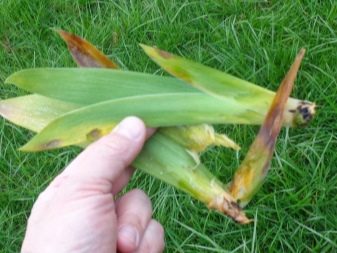
The next disease in terms of the frequency of lesions is penicillosis or "storage rot" - a fungal disease. Tubers that have been kept for a long time at temperatures below + 16 ° C at high humidity are infected. At the same time, light brown spots are found on the inner scales of the bulbs, and then completely the scales acquire a brown color, become soft. Such plants grow very slowly, poorly form a root system, there is a characteristic drying out of the tips of the roots, the stems become brittle. Prevention: store the planting material in a well-ventilated area, where the humidity is not more than 70%; in case of premature regrowth of the roots, the bulbs must be planted in the ground.

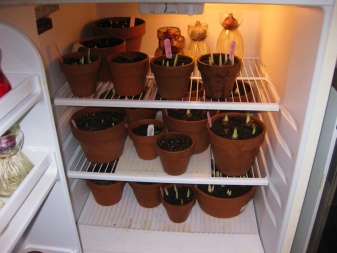
Various pests can cause great damage to hyacinths. The most popular parasite is flower fly larvae, which eat the bases of the leaves, thereby gnawing the bottoms of the plants. Effective means for saving flowers are Tabazol, Mukhoed and Aktara.
Onion mites can also do a lot of harm, the fight against which consists in mulching the earth around the flowers. But the most difficult opponent is the bear. The peak of its activity falls in the month of May, when the earth warms up, and the parasites begin to eat the already planted bulbs. To combat pests, shallow pits are dug on the site, filled with manure as bait and covered with a large piece of slate or board. After 2–4 weeks, the bear should be etched out with such means as "Beard", "Boverin", "Grizzly" or "Medvetoks".
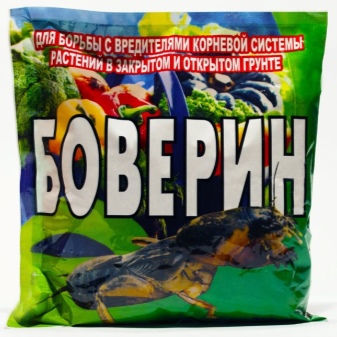
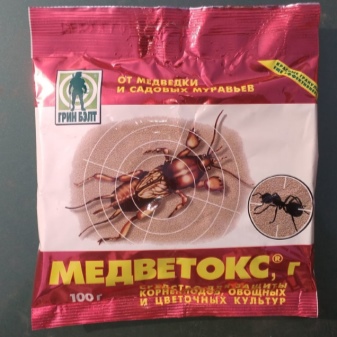
Forcing hyacinths
Forcing is the artificial sprouting of a bulb. Many people confuse forcing with planting this plant in open ground, and are generally confused when to plant hyacinth, in spring or autumn? Let's understand these concepts.
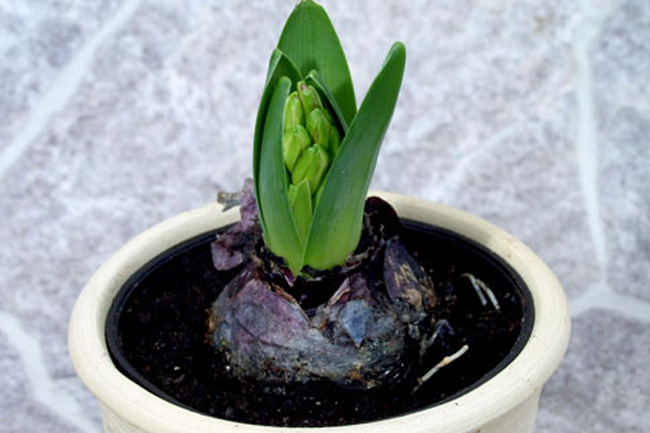
It is quite another matter if you plan to plant a hyacinth in your garden in a permanent place so that it grows there and delights you with its beauty. This is already called planting, it takes place in compliance with the natural requirements of the plant.
According to the rules, planting hyacinths is carried out in the fall, it is the autumn cool period that the bulb takes root and lays a flower bud. After that, having successfully overwintered, in the spring it will decorate your garden with its flowers.
When forcing, this cool dormant period will have to be imitated, or specially prepared bulbs will have to be purchased.
If we buy bulbs from shops and garden centers, they must be marked for winter distillation, which indicates that the bulbs have gone through the cooling period and have been properly prepared.
The bulbs should be large (5 cm or more in diameter), healthy and strong, in a word, ready for the hardships of winter flowering. They should be free of mold and rot, and should not be soft. Before planting, we store them in a dark, dry place at a temperature of 16-17 degrees.
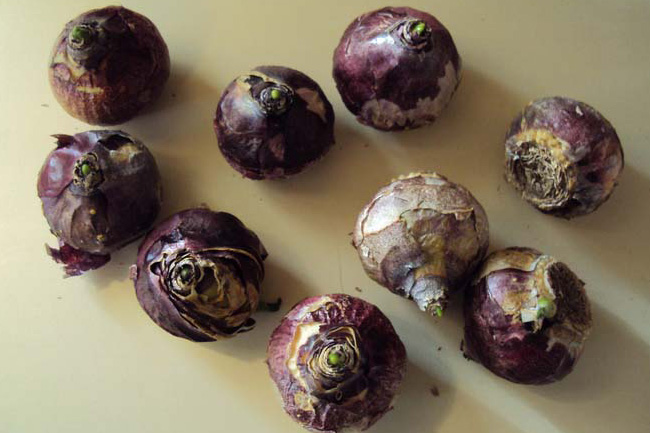
If you want to distill the plant from your own bulbs, from your garden, then you will need to prepare them yourself, going through several stages. It is necessary to dig them out in advance (from June 20 to July 5), dry thoroughly at a temperature of 25-30 degrees and store at 17-20 degrees in a dark room.
Forcing in pots with soil
2-2.5 months before the expected flowering date, the bulb must be planted in a pot. To do this, we use a not very large container, put a drainage layer on the bottom, fill in a suitable soil.
Before planting, remove the babies from the bulbs, if any, and bury them (bulbs) 2/3 into the ground so that only the top of the head remains sticking out. The soil should be moderately moist. The bulbs of this plant do not have a dense protective shell and therefore easily rot from excess moisture.
The next step will be a cooling period. For our plantings to take root, they need coolness, darkness and a temperature of only 4-9 degrees. For these purposes, a basement or cellar, a glazed loggia, a heated garage, a cold storage room, a refrigerator are suitable.
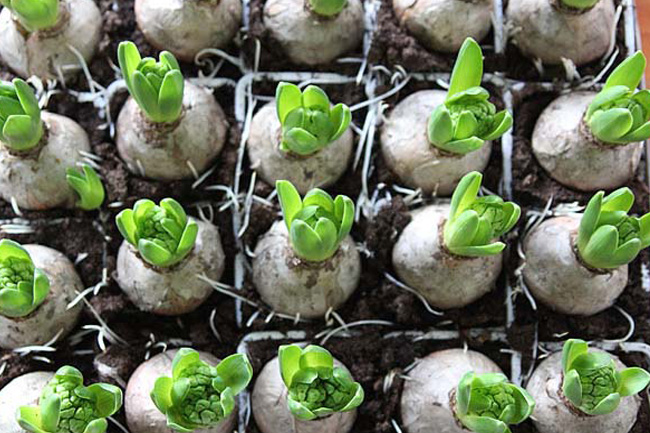
There the bulbs take root, give the first leaves and a peduncle. After that, they can be taken out and placed in a well-lit place. At first, hyacinths transferred from a dark place to a bright light will need to be shaded.
Very often, the surface of the earth in a container with hyacinths is mulched with moss or lichen. This not only gives an attractive decorative look, but also prevents the soil from drying out quickly.
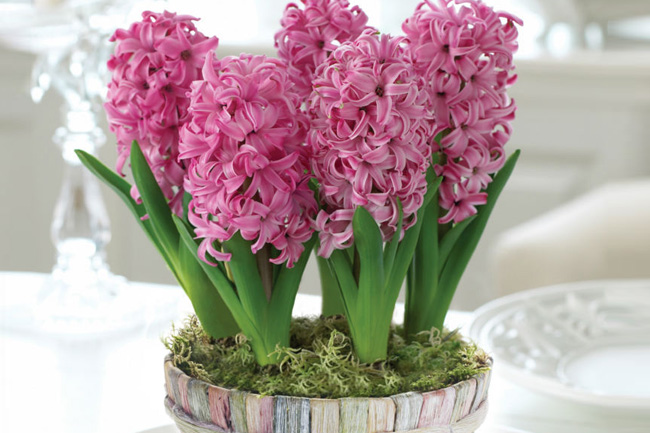
Forcing hyacinths in water
Another interesting method is forcing the hyacinth bulbs in water. The technology is almost the same, but for germination, a glass container is used that is suitable in size, with a wide neck, to which the bulb is installed. Water is poured inside, its amount should not be less than 300 ml. The distance between the bottom of the bulb and the water should be about 2 cm to avoid decay.
The plant will take root by itself and reach the water. When the bulb is set, it must also be placed in a dark, low temperature place until the root system and flowering leaves are developed. A refrigerator will do. During the entire time of germination, water must be added to the vessel with the flower.
Once the leaves and flower arrow appear, the plant can be transferred to heat. The peduncle must be covered with an opaque material until it reaches 10 cm. Complex fertilizer can be added to the water.
In the warmth, hyacinths develop and bloom quickly.
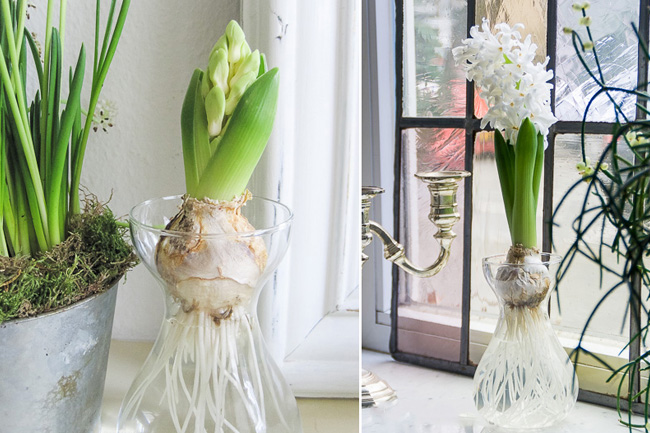
But, with regard to this method, it should be noted that flowering when distilled in water will last less, and the bulb itself will be greatly depleted. Therefore, if you plan to grow hyacinth more than once, then the bulb will need to be planted in the garden in the fall.
A detailed video about forcing hyacinths in water:
Distillation in hydrogel
An innovative method of forcing a plant that uses a hydrogel instead of soil and water.
The hydrogel balls are poured with water with a complex fertilizer, according to the instructions, and placed in the filled container of the hyacinth bulb. The subsequent actions are the same as in the two previous methods: installation in a dark, cold place, and subsequent transfer to warmth to light.
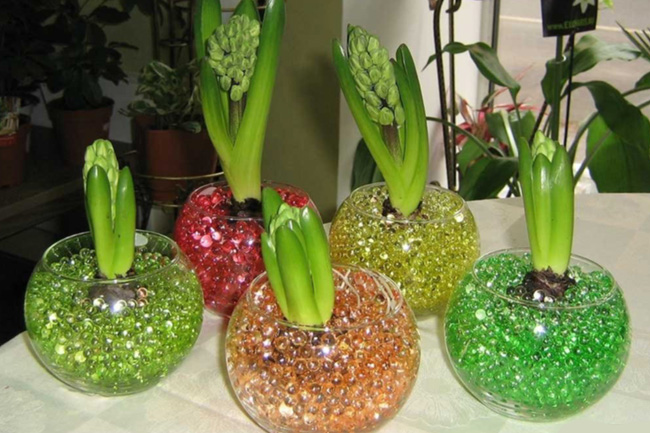
Examples in landscape design
The close planting of flowers to each other allows you to freely create flower beds, borders, lawns and other landscape fads from hyacinths. They are often paired with other spring flowers such as tulips, daffodils, primrose, or pansies. Tall buds will also work well against a backdrop of undersized crops like daisies and daisies. The variety of colors allows you to make flower beds and compositions consisting only of hyacinths. Monotonous "carpets" of these colors look no less beautiful.

For information on how to plant hyacinths correctly, see the next video.


